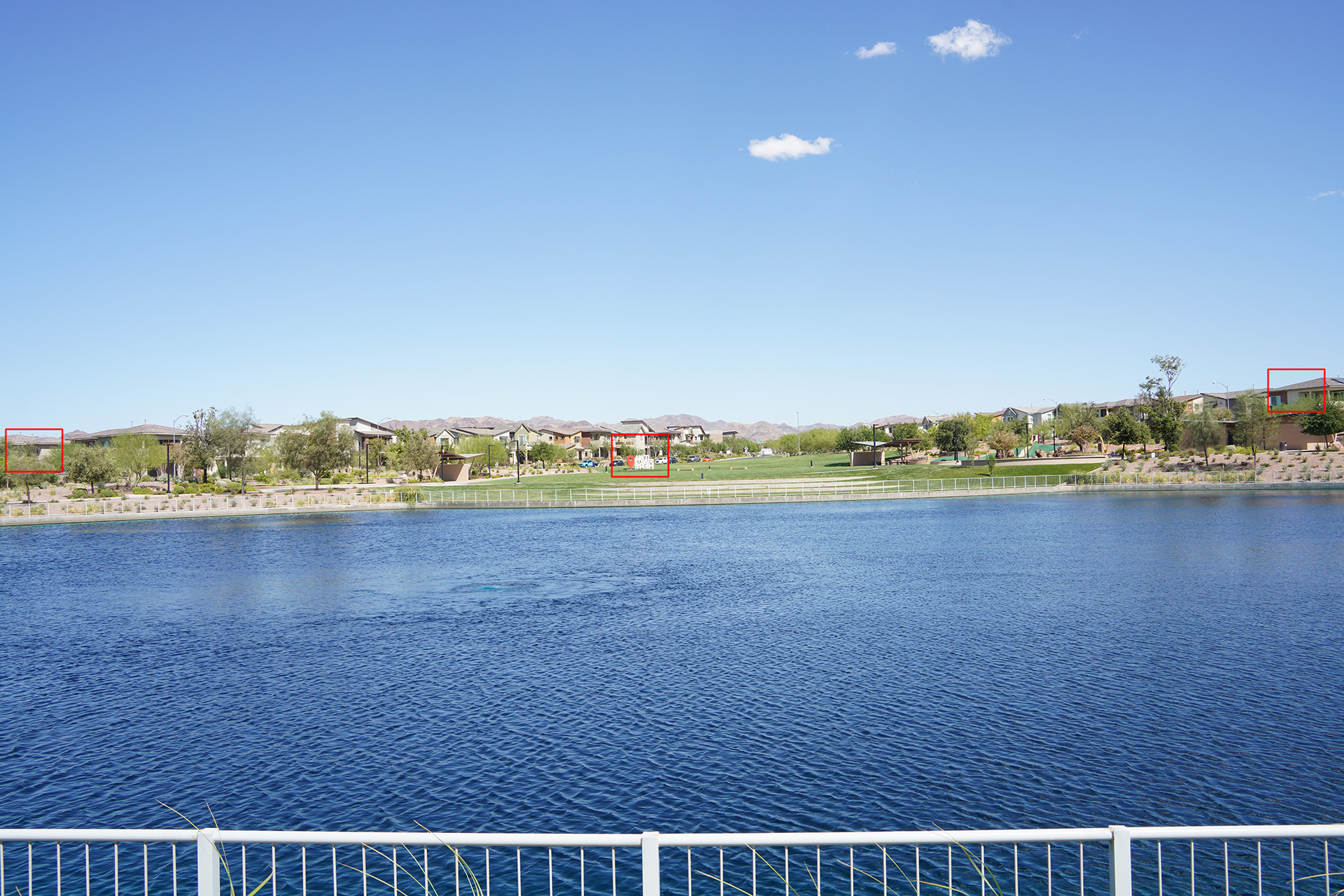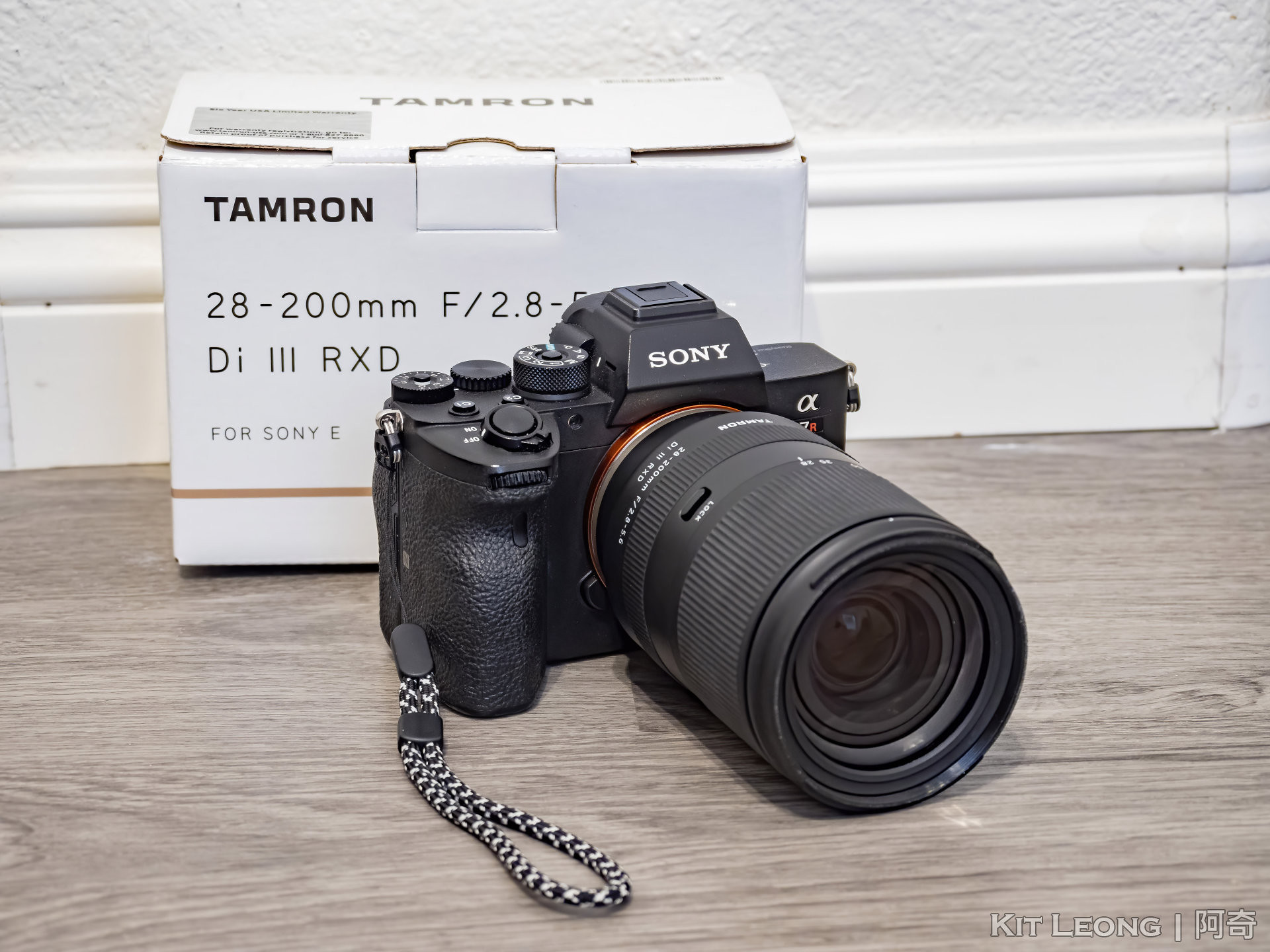While it's true that you can change camera lenses, sometimes, especially for travel or less critical occasions, carrying multiple lenses can be cumbersome. Throughout the years, whether it's been a compact DC camera, a DSLR, or a mirrorless camera, I've always had a special preference for travel lenses with 7x optical zoom or more. However, having just one good option isn't enough; generally speaking, travel lenses are often criticized for their subpar performance.
Currently, the pinnacle of contemporary travel lenses might be the Olympus 12-100mm F4 Pro, but it's designed for the M43 system, not the system discussed in this article. In the past, Sony's native E-mount full-frame travel lens was limited to the Sony FE 24-240mm F3.5-6.3 OSS. However, after a brief period of real-world use, I found myself somewhat disappointed with its overall performance and decided to part ways with it.
Finally, Tamron's introduction of the 28-200mm F2.8-5.6 DI III RXD seems to herald a new chapter for Sony full-frame travel lenses...
This will be a long article. Feel free to skip to the section you want to read:
- Key Specifications
- Appearance
- Aperture dropping speed is not that fast
- Amazing Resolution, but Weaker Chromatic Aberration Performance
- Real-world Outdoors Comparison with Tamron 28-75mm F2.8
- Flare and Ghosting
- Minimal Distortion
- Vignetting
- Focusing Speed
- Does Lack of Image Stabilization Affect Much?
- Impressive Maximum Magnification
- Acceptable Starburst Effects
- Final Thoughts and More Real-Life Samples
Key Specifications
- 28-200mm 7.1x optical zoom
- Wide-angle aperture of F2.8, which is a unique feature for high-magnification travel lenses... (Telephoto end is only F5.6)
- Optical structure consisting of 14 groups and 18 elements, including 1 XLD ultra-low dispersion lens element, 2 LD low dispersion lens elements, 2 double-sided aspherical lens elements, and 2 molded glass aspherical lens elements
- 7 rounded aperture blades
- Minimum focus distance of 19cm at the wide-angle end, achieving a magnification ratio of 1:3.1
- Minimum focus distance of 80cm at the telephoto end, achieving a magnification ratio of 1:3.8
- 67mm filter thread
- Dimensions of 74mm x 117mm, weighing only 575g
Appearance
For a full-frame lens, this travel lens with an F2.8 aperture at the wide end is relatively lightweight, sharing similar dimensions and weight with its sibling, the Tamron 28-75mm F2.8 DI III RXD. Additionally, its design and build quality are so similar that it's challenging for unfamiliar observers to distinguish between them.
It's a bit regrettable that this lens begins at 28mm, but it's understandable. If it were forced to start at 24mm, it would increase in size and weight, potentially affecting its performance. In practice, 28mm or 24mm aren't extremely wide angles, and as a photographer, I typically use other lenses for ultra-wide shots, such as 12mm or 15mm lenses. Therefore, starting at 28mm is acceptable to me.
↑This travel lens maintains good balance on Sony full-frame bodies in terms of size and weight.
↑The two lenses are almost identical, with the 28-200mm lens being slightly shorter by 1mm, narrower by 1mm, and weighing only 25g less.
↑The compactness of the lens when fully retracted is likely related to its two-piece design
↑The zoom ring's damping feel is similar to that of the 28-75mm lens, making it reasonably responsive. The lens also has a lock switch to prevent accidental movement
Aperture dropping speed is not that fast
The Tamron 28-200mm F2.8-5.6 indeed features a larger aperture compared to many previous travel lenses, approximately half a stop larger than, for instance, the typical aperture design of a travel lens like the Sony FE 24-240mm F3.5-6.3. But before delving into the necessity of this half-stop increase, let's examine the maximum aperture at mid-range focal lengths...
| 24/28mm | 35mm | 50mm | 70mm | 105mm | 135mm | 200/240mm | |
| Tamron | F2.8 | F3.2 | F3.5 | F4 | F4.5 | F5 | F5.6 |
| Sony | F3.5 | F4 | F4.5 | F5.6 | F6.3 | F6.3 | F6.3 |
In the table above, Sony's lens has a typical aperture change rate, with the maximum aperture decreasing quite rapidly. However, Tamron's new lens still maintains an F4.5 aperture at around 105mm, and in the 135-200mm range, the aperture only decreases by half a stop. In terms of F-number, the difference isn't significant, but in terms of light-gathering capability, the Tamron lens does offer a certain advantage.
Amazing Resolution, but Weaker Chromatic Aberration Performance
Many people might say, 'Don't expect too much from a travel lens.' It's true, but we tend to be a bit greedy. Balanced overall performance with stronger optical capabilities would be even better, wouldn't it? But if you're pursuing ultimate image quality, then perhaps no travel lens, no matter how good, is the right choice for you.Historically, especially in the realm of full-frame lenses, travel lenses have often fallen short. They tend to deliver acceptable image quality in the front half but disappoint in the rear half, with mediocre focusing speed, among other shortcomings. This is the common impression people have of travel lenses.
Currently, my main camera is the Sony A7R IV, a machine with a whopping 60 million pixels. The optical performance of the lens becomes more evident on such a camera, so when Tamron 28-200mm was first released, I had high hopes for it but was also wary. However, after real-world use, I was genuinely impressed. Surprisingly, it often competes neck and neck with the Tamron 28-75mm F2.8 in terms of resolution.

↑This is a real-world JPEG shot at 28mm with the aperture wide open.
Sony A7R IV, ISO 100, F2.8 1/1250s

↑The above image is a 100% crop, left: center, right: extreme edge.

↑This is a real-world JPEG shot at 200mm with the aperture wide open.
Sony A7R IV, ISO 100, F5.6 1/360s

↑The above image is a 100% crop, left: center, right: extreme edge.
However, in terms of chromatic aberration performance, the Tamron 28-200mm F2.8-F5.6 exhibits some noticeable fringing or slight purple fringing across the entire focal range when the aperture is wide open. This is especially evident at the wide-angle end with the aperture wide open, showing noticeable fringing and less solidity. Stopping down the aperture by 1-2 stops improves the situation significantly, but sometimes purple fringing is still visible, no matter how much you stop down. However, if, like me, you mainly shoot in RAW, correcting this purple fringing in Lightroom is not a big issue.

↑In situations like shooting directly into the sun, purple fringing becomes more pronounced.
Sony A7R IV, 28mm, ISO 100, F9, 1/80s

↑The above image is a 100% crop, demonstrating some chromatic aberration situations.
Real-world Outdoors Comparison with Tamron 28-75mm F2.8
Next, let's compare the real-world performance of the Tamron 28-200mm F2.8-5.6 DI III RXD with the Tamron 28-75mm F2.8 DI III RXD in outdoor shooting with 100% crops. Both shots were taken on a tripod, with a two-second countdown, manual focusing, and so on.
In real-world shooting, I first noticed that even when both lenses are set to 28mm at the widest focal length, the 28-75mm lens is slightly wider.

↑At the same focal length, the 28-75mm has a slightly wider field of view than the 28-200mm. In the example, both are set to 28mm, but the 28-75mm is slightly wider, as indicated by the red box.
Wide Angle at 28mm
For the real-world shots at 28mm, I divided the image into left, center, and right sections for 100% crop analysis. Both lenses exhibit some noticeable chromatic aberration when the aperture is wide open, but resolution in the center is excellent for both. From F2.8 to F5.6, the 28-200mm lens seems slightly better than the 28-75mm lens, but beyond F8, the 28-75mm lens performs even better.
However, when it comes to edge performance, it's a bit mixed. At 28mm, the 28-200mm is slightly better on the left side, while the 28-75mm is better on the right side. This could be due to differences in focus areas, the distances to the houses on the left and right sides, or slight deviations from the center in hand-held shots.
Overall, considering everything, the 28-200mm's performance at the wide end, apart from noticeable weaknesses when the aperture is wide open at the edges, is quite impressive.

↑ Diagram showing the position of the 28mm sample crops.

↑ 100% crop comparison at 28mm
Left: Tamron 28-75 FE, Right: Tamron 28-200

↑ 100% crop comparison at 28mm on the left edge
Left: Tamron 28-75 FE, Right: Tamron 28-200

↑ 100% crop comparison at 28mm on the right edge
Left: Tamron 28-75 FE, Right: Tamron 28-200
Mid Telephoto at 75mm
As for the performance at 75mm, I'm particularly interested. Imagine this: the 28-200mm still has an F4 aperture at 75mm, which can be seen as a slightly variable aperture version of the original 28-75mm F2.8. If the 28-200mm performs well in this focal range, the need for the original 28-75mm F2.8 might diminish.
For the comparisons at 75mm, I once again divided the image into left, center, and right sections for 100% crop analysis. In the center, both lenses show more noticeable chromatic aberration when the aperture is wide open. However, the 28-75mm improves significantly by stopping down one stop, resulting in much less chromatic aberration than the 28-200mm at 75mm F4. Beyond this, both lenses perform excellently, with the 28-75mm being slightly sharper.
When it comes to edge performance at 75mm, although not as pronounced as at the wide angle, the pattern continues. The 28-200mm is slightly better on the left side, while the 28-75mm is better on the right side. However, there might be variations in the focus plane or distances to the houses on the left and right sides, so take this into account.
Overall, at 75mm, the 28-200mm performs slightly less sharp than the 28-75mm, but the difference isn't substantial. It seems to excel more in this focal range compared to the wide-angle end.

↑Diagram showing the position of the 75mm sample crops.

↑ 100% crop comparison at 75mm
Left: Tamron 28-75 FE, Right: Tamron 28-200

↑ 100% crop comparison at 75mm on the left edge
Left: Tamron 28-75 FE, Right: Tamron 28-200

↑ 100% crop comparison at 75mm on the right edge
Left: Tamron 28-75 FE, Right: Tamron 28-200
Telephoto End at 200mm
The Final 200mm End is the Focal Length "Added" Compared to the 28-75mm lens, where many travel lenses often suffer in performance at their maximum telephoto ends. Fortunately, the performance at the maximum telephoto end is also impressive. When the aperture is wide open, there's very usable resolution, and the change in resolution when stopping down the aperture is minimal. Chromatic aberration seems to persist regardless of the aperture, but it's not too severe./p>
With such performance, I sometimes use this lens for "birding" as well. Leveraging the 60MP ultra-high resolution of the Sony A7R IV, even when using APS-C mode, you still get 26MP of high resolution, resulting in an equivalent focal length of 300mm. Some less timid animals are now within the range of photography. I've also shared some photos and their original images at the end of this article for your reference.

↑200mm示意裁切位置圖

↑ Diagram showing the position of the 200mm sample crops
Left: Center, Right: Left edge
Flare and Ghosting
Many lenses tend to exhibit strange reflections, light flares, or ghosting when faced with strong light. Modern lenses often have proprietary coatings to reduce the occurrence of these artifacts. Overall, this lens performs quite well in this regard. While there is some flare and ghosting, it's within what I find acceptable. You can clearly see the extent of these artifacts in the video I shot with this lens when facing the moving sun.

Minimal Distortion
Many modern lenses have what's known as "digital correction" to mitigate distortion, among other things. Generally, digital correction is most effective in controlling distortion, edge light loss, and mitigating some purple fringing.
I'm not opposed to various types of digital correction, as long as it's done well and doesn't adversely affect actual shooting. So, in this article, I'm not specifically turning off digital correction or intentionally shooting in RAW and not correcting to see how "ugly" it originally is.
This lens also has digital correction functionality, and the distortion control is actually very good when corrected. In real-world shooting, distortion is not easily noticeable. So, in this section, I'll save some effort and not include images.
Vignetting
As mentioned above, digital image correction also "optimizes" edge light loss. If you turn off digital correction for this lens, edge light loss will be more noticeable, roughly about one stop, but why would you want to turn off digital correction?
Basically, there is some edge light loss at all focal lengths when the aperture is wide open. Typically, when you stop down by about one stop, edge light loss becomes hardly noticeable. In fact, even when shooting with the aperture wide open, edge light loss is generally not very noticeable unless your subject's background is a solid color like the sky.

↑When shooting with the wide-angle end fully open, Vignetting is noticeable, but it's almost completely corrected when stopped down by one level.

↑At the telephoto end, Vignetting is relatively more pronounced, but when stopped down by about two stop, there's almost no issue.

↑ In indoor shooting, Vignetting is actually not that noticeable.
28mm F2.8
Focusing Speed
I'm too lazy to provide an actual recording for this part, so I'll describe it in words. This lens, like the 28-75mm F2.8, uses an RXD high-speed silent autofocus motor. So you can expect its performance to be similar. In general, AF-C is very fast and similar to the original lens, while AF-S is normal but still a bit faster than the 28-75mm. However, with modern Sony full-frame cameras, I'm used to almost always using AF-C for focusing, which is quite convenient.
Does Lack of Image Stabilization Affect Much?
Modern Sony full-frame cameras have built-in five-axis image stabilization, and its effectiveness can be described as acceptable but not exceptional. So, can you still use the 28-200mm without optical stabilization? It's not necessarily a deal-breaker. Even without optical stabilization, Sony's five-axis in-body stabilization helps a lot. As long as you have good shooting habits and proper posture, it shouldn't be a major issue. Here's a video of handheld shooting at an equivalent of 300mm (APS-C mode) with this lens. You can see how stable it is.

Impressive Maximum Magnification
Maximum magnification is another highlight of this lens. It offers useful magnification rates at almost all focal lengths, making it very convenient for everyday photography or occasional close-up shots. The maximum magnification is particularly impressive at the wide-angle end, with 19cm at 1:3.1, and it's still quite good at the telephoto end, offering 80cm at 1:3.8.

↑The magnification rate at the maximum telephoto end is still at 1:3.8, making it suitable for macro photography, especially when combined with APS-C Mode
Sony A7R IV (APS-C Mode), 200mm, ISO 400, F8, 1/640s
Acceptable Starburst Effects
This lens, like the 28-75mm F2.8, has seven rounded aperture blades, resulting in a similar starburst effect. When point light sources are sufficiently bright, you'll start to see some starburst patterns at around F5.6, which becomes more pronounced at F8. However, I find F11 to be the best balance point. While F16 might produce better starburst patterns, diffraction effects become more apparent, and overall image quality drops, which I don't prefer.

↑For larger point light sources, the starburst effect becomes noticeable after F8
Sony A7R IV, 28mm, ISO 1600, F11, 1/3s

↑For smaller point light sources, the starburst effect is generally noticeable at least from F11 onwards
Sony A7R IV, 90mm, ISO 200, F11, 3.2s
Final Thoughts and More Real-Life Samples
| Advantages | Average | Potential Improvements |
|
|
|
In the full-frame system, especially under Sony's full-frame system, it's not an exaggeration to call it the ultimate full-frame travel lens. The F2.8 aperture at the wide end is quite a feat, even though it's not much larger than many travel lenses that start at F3.5. But sometimes, that extra bit of brightness can be advantageous, especially in low light. Think about the difference between F1.4 and F1.8 lenses; sometimes, that gap sometime is significant.
Another highlight is the overall image quality across the entire focal range. It surpasses many full-frame travel lenses from the past by a considerable margin. In many cases, it can even compete with the 28-75/2.8 in practical capabilities.
Of course, if you prioritize absolute image quality above all else, this type of lens may not be suitable for you. Travel lenses are valued for their convenience. Personally, I don't like changing lenses unless it's necessary, especially with Sony's full-frame system. Based on experience, no matter how careful you are, dust can find its way in after a few lens changes. The worst is when you don't notice dust spots immediately and you're shooting video. It's a tragedy, as video dust spots are not as easy to handle as those in photos.
VS Sony FE 24-240mm F3.5-6.3 OSS?
I suppose many of you might find it disappointing that this lens starts at 28mm. Indeed, but if it were to start at 24mm and sacrifice image quality significantly or increase in size and weight considerably, I think that might be less appealing. The Sony FE 24-240mm, in particular, performs modestly. It's usable at 24mm, but edge performance is somewhat lacking, which is a bit unfortunate. At the same time, its performance at 240mm is somewhat lackluster, so whether those extra two segments are useful depends on personal shooting habits. For me, the most commonly used focal range is around 15-200mm (unfortunately, there's no such lens, and even if there were, it would either be too large, too heavy, or too poor in performance). So, for me, 24-105mm seems a bit short and bulkier and heavier.
VS Tamron 28-75mm F2.8?
This... I've mentioned the comparison between these two lenses throughout the article. I think you should have a good idea by now. It's not that the 28-75 isn't good; it's just that the 28-200mm performs quite well in the 28-75mm segment, making the necessity of the 28-75 somewhat weaker. The difference in image quality is not significant, but in terms of convenience, there's a substantial gap. Personally, I would choose convenience.
Final Thoughts
If you're also using the Sony FF system and want a versatile travel lens for everyday convenience, the Tamron 28-200mm F2.8-5.6 DI III RXD A071 is a lens worth considering. Of course, if you don't mind the extra effort and prioritize image quality, the original manufacturer's trinity is still the best choice. No matter how strong a travel lens is, it's still a travel lens.
Finally, here are some more real-world sample photos taken with this lens

↑Sony A7R IV, 77mm, ISO 320, F7.1, 1/160s

↑Sony A7R IV (APS-C Mode), 200mm, ISO 1600, F8, 1/320s

↑Sony A7R IV, 200mm, ISO 640, F5.6, 1/160s

↑Sony A7R IV, 28mm, ISO 100, F9, 1/160s

↑Sony A7R IV, 200mm, ISO 100, F5.6, 1/125s

↑Sony A7R IV, 28mm, ISO 1600, F2.8, 1/5s

↑Sony A7R IV, 28mm, ISO 800, F4.5, 1/15s

↑Sony A7R IV, 28mm, ISO 640, 1/15s






